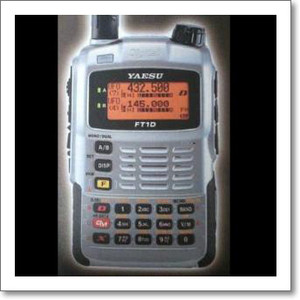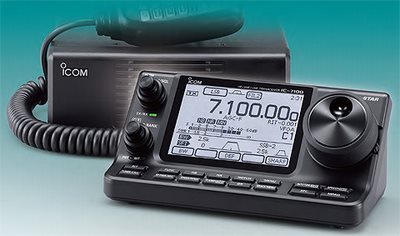Posts Tagged ‘D-Star’
 New Transceiver from ICOM: IC-7100
New Transceiver from ICOM: IC-7100
ICOM has shown the new IC-7100 at the JARL show in Tokyo. The interwebz is buzzing with information, including a preliminary data sheet.
My scan of the preliminary datasheet indicates that this radio is in the class of the IC-7000 or even the IC-706. It covers all modes on HF plus 6 Meters, 2 Meters and 70 cm. (It also has the 70 MHz band which is a nice add for the European countries that have that band.) The radio includes DV (D-STAR) modulation capability and has a new touchscreen user interface. The slanted control panel is meant to make the touchscreen more accessible.
A new HF plus VHF/UHF radio always gets my attention (see my plea for an FT-950 with 2 Meters). I am starting to think that the real benefit of this rig is the addition of D-STAR capability, which would a good but not essential feature to have.
What do you think?
73, Bob K0NR
Update (30 Aug 2012): Universal Radio has the radio on its website.
There’s a good video look at the radio here.
 A New Digital VHF/UHF Radio from Yaesu
A New Digital VHF/UHF Radio from Yaesu
 A while back, Yaesu published a white paper/brochure on VHF/UHF digital technology that slammed D-STAR for using GMSK modulation and stated that C4FM (4-Level FSK) is the way to go. See my previous posting on that topic. The paper also talked about DMR and APCO 25 as standards that use C4FM.
A while back, Yaesu published a white paper/brochure on VHF/UHF digital technology that slammed D-STAR for using GMSK modulation and stated that C4FM (4-Level FSK) is the way to go. See my previous posting on that topic. The paper also talked about DMR and APCO 25 as standards that use C4FM.At this point in time Vertex Standard believes the C4FM (4-level FSK) FDMA or TDMA are the most suitable selections for Amateur radio applications. In early 2012, we will release a C4FM (4-level FSK) FDMA Handy-Talky and a Mobile transceiver into the Amateur radio market. After our initial introduction, we plan to introduce a C4FM (4-level FSK) TDMA (2 slots) or TDMA Handy and Mobile transceiver into the Amateur market.
 Hamvention from afar…
Hamvention from afar…

I was unable to make it out to Dayton but am enjoying seeing the onsite action through various mediums:
(1) w5kub.com – live streaming. It has been a bit hit and miss on the quality and coverage, but the feed is quite popular and it is a lot of fun seeing all the hams walking around the outdoor market. Lots of hams in front of the live feed cam seem to stand there, stare at the camera, and call home (or a buddy) to have them get on the website to see them on the live feed. At certain times the live feed appears to be an actual video version of hamsexy.com. The best part about amateur radio is the people and it is always great to see what an amazing variety of folks who share a common interest.
(2) Jeff, KE9V, is on the grounds of the Hara Arena and is frequently Tweeting and posting pictures. Jeff had an interesting picture of a vendor called Horse Fence Antennas. The product appears to be a dipole antenna that is built into what we in the Army call a cargo strap. The antenna looks a bit bizzare, but the eHam reviews are 5.0.
(3) D-STARS! I have not hooked up my DVAP and IC-92AD since I returned for Korea, but did so yesterday so I could monitor REF038C. Lots of great hamvention chatter on the reflector.
(4) I am going to look for any HF stations operating from the Hamvention. Often W1AW will setup up a special event station – those are always fun to work.
Hopefully I will be able to go next year…. 2013, Dayton or bust!
 Icom IC-E92D – Why This Is My ‘Staple’ Handheld
Icom IC-E92D – Why This Is My ‘Staple’ Handheld
 |
| Icom IC-E92D |
 |
| Built for the outdoor life - with HM-175 GPS Speaker-Mic |
| SMA - SO239 adaptor |
 DCS: Also Reflecting Our National Traits
DCS: Also Reflecting Our National Traits
 |
| UK DCS005 shown on he excellent (German) DV-RPTR Control Centre software |
 D-STAR Makeover
D-STAR Makeover
No longer will your beautiful, eloquent, flowing QSO be 'bumped' abruptly and permanently off the air by a random mobile station the other side of the world 'pinging' his local repeater for a few milliseconds. You can now even QSY to a 'chat' module and not hog the repeaters of an entire nation while you discuss your passion for North Korean tractor parts for three hours.
The advent of DCS reflectors, hand-in-hand with the German DV-RPTR boards shipped all over the world, is going to save the mode from extinction, no less. Witness the used D-STAR radios in the graveyard of Ebay as testament to the disillusioned DPlus users.
If only they'd have waited.
 |
| The DV-RPTR unit in its housing |
*UPDATE 24th April 2012: Looks like the Dplus system has been suddenly revamped to include the routing information with the voice packets in the same way as DCS. Shame it took seven years of dysfunctional communications and a rival system to prompt this. I'll be staying on the DCS system - but enjoy whichever system you use and enjoy the mode!
 Show Notes #076
Show Notes #076
Introduction:
- Only 317 days until the end of the world as we know it!
Announcements:
- The Black Sparrow Media application for iPad, iPhone and iPod has been submitted to the iTunes store. It is just awaiting validation from Apple, which may take up to two weeks. We’ll let everyone know when it’s available.
- Special Event Station W0S (Whiskey Zero Sierra) will be operating from the Titanic Branson Museum from April 13-15, 2012, commemorating the 100th anniversary of the Titanic disaster. Russ, K5TUX, will be operating the station at some point.
Feedback:
- Scott, AD7MI, asks for help linking APRS and his his Davis Vantage Pro2 weather station with Xastir. Our hosts suggest trying one or both of these:
- Meteo – Davis weather station platform software for Linux. You can subscribe to the Meteo mailing list by sending a subscription request to [email protected]. It has been several years since Meteo was updated, and is still not at version 1.0. You must download the .tar file from the web site as it does not appear in the distribution repositories.
- wview- Cross-platform weather station software. It does need an internet connection if you are going to contribute information to various weather sites, such as:
This program is under active development. Even if it requires a work-around to perform as you wish, it may be worth the trouble. If you’ve ever configured a Linksys router, the web interface of wview looks a lot like that. wview has a support site via Google Groups at http://groups.google.com/group/wview.
Let us know how you get on, Scott!
Russ signed up for the AllStarLink network; it’s very similar to joining EchoLink. AllStar uses the Asterisk VOIP system, and Jim, WB6NIL, is the author of the repeater link software. Russ had success using a Mac computer, but not with a Linux machine.
Richard sees the biggest problem with EchoLink is that it only allows one connection per IP address, so you can’t have both a server and client at home. The EchoLink site only sees your IP address assigned by your ISP, which limits you to one connect from home. In this respect, AllStarLink appears to better in that it seems to allow multiple connections.
AllStarLink is available in several combinations of Linux and Asterisk:
- ACID – based on CentOS
- Limey Linux – based on embedded Linux and bootable from a flash drive, and runs ONLY on several specific Mini-ITX motherboards.
- Pickle – a specialized embedded Linux distro designed to operate on a BeagleBoard-xM (and DMK Engineering LOX board).
Russ then provides an overview of setting up an AllStar Link client.
Richard defends the use of “mode” as appropriate as the definition allows it to mean “a method or means of doing something”. For example, CW vs DFCW (dual-frequency CW), where DFCW uses frequency shifts to distinguish dots and dashes, rather than two different lengths of the same frequency, and spaces. Both are CW.
Contact Info:
- Contact Richard at [email protected], Russ at [email protected], or both at the same time at [email protected].
- Listen to the live stream every other Tuesday at 8:00pm Central time. Check the LHS web site for dates.
- Leave us a voice mail at 1-909-LHS-SHOW (1-909-547-7469), or record an introduction to the podcast.
- Sign up for the LHS mailing list.
- Sign up for the MAGNetcon mailing list.
- LHS merchandise is available at the Merch link on Web site. Check out the Badgerwear or buy one of the other LHS-branded items at PrintFection.com/lhs or Cafe Press. Thanks!
- Thanks to Dave from Gamma Leonis for the theme music.
Music:
- To be added.












